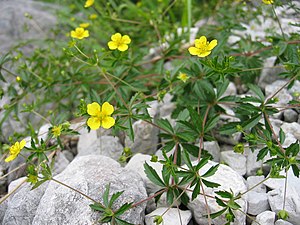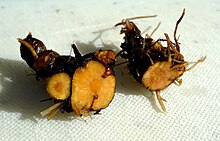Tormentil
| Tormentil | ||||||||||||
|---|---|---|---|---|---|---|---|---|---|---|---|---|

Bloodroot ( Potentilla erecta ) |
||||||||||||
| Systematics | ||||||||||||
|
||||||||||||
| Scientific name | ||||||||||||
| Potentilla erecta | ||||||||||||
| ( L. ) Raeusch. |
The plant species bloodroot ( Potentilla erecta ), also called Dilledapp , Durmentill , Natter (n) wurz , Rotwurz , Ruhrwurz , Siebenfinger or Tormentill , belongs to the rose family (Rosaceae).
description
The bloodroot is a perennial herbaceous plant that usually reaches heights of 10 to 30 (5 to 50) centimeters. It grows from a strong and creeping rhizome , which has a diameter of 1 to 3 cm, is lignified and turns blood red on the inside at cut surfaces. The upright to prostrate stalk is multi-branched, leafy and hairy differently. The long-stalked rosette leaves are three-part (rarely individual four- to five-part), coarse and serrated, in contrast to the seated to short-stalked stem leaves, which are always three-part. There are three to five large stipules , which is why the leaves appear in several parts.
The flowers , which arise individually on long stalks in the leaf axils, have a diameter of about 1 centimeter. The sepals are more or less as long as petals. The mostly four (sometimes five or six) yellow petals are free, inverted-heart-shaped and 4 to 5 mm long.
The flowering period extends from May to October.
The number of chromosomes is 2n = 28.
ecology
It is not uncommon for plant galls to form on the stem , caused by the gall wasp Xestophanes brevitarsis . The denaturation can reach down to the rhizome. The bloodroot has roots up to 50 centimeters deep.
Pollination is carried out by insects. The fruits are wind and animal spreaders, and the seeds also spread randomly .
distribution
The range of the tormentil includes the boreal and temperate zones of Europe eastward to the Altai . In the south it occurs only in the mountains. Occurrences in eastern North America may be due to introduction.
Mixed forests , heaths , rough meadows , fens with moderately acidic soils are preferred as locations . The plant is considered an indicator of leanness. In Central Europe it occurs particularly in societies of the Nardo-Callunetea class, but can also grow in acidic societies of the order Molinietalia or the associations Polygono-Trisetion or Quercion roboris. It rises in Germany in the Alps to altitudes of 2200 meters.
Systematics
It was first published in 1753 under the name Tormentilla erecta by Carl von Linné in Species Plantarum . Ernst Adolf Rauschel published the name Potentilla erecta (L.) Raeusch , which is recognized today in 1797 . Other synonyms are Potentilla sylvestris Neck. and Potentilla tormentilla Neck.
use
The bloodroot takes its name from the blood-red sap that emerges from the yellowish-white rhizome when it is cut. In the Middle Ages , tormentil was still used to describe various drugs that were believed to have hemostatic properties, but today we only mean tormentill, which modern phytotherapy values as an excellently tolerated tannin drug that relieves acute diarrhea. In some regions, e.g. B. in the Bavarian Forest , a liqueur or schnapps is made from bloodroot , which is served as a digestif .
Bloodroot in phytotherapy
In herbal medicine , the black-brown rhizome, preferably dug up in spring or autumn (shortly before or shortly after flowering), dried in the sun, freed from the roots and chopped up is used ( Tormentillae rhizoma ), either as an alcoholic extract ( tincture ), or as tea. Active ingredients, in addition to tannins ( tannins ) the red dye Tormentol , the glycoside Tormentillin , flavonoids , phenolic carboxylic acid , saponins , resin , rubber and essential oils . The sap of the plant has an inhibitory effect on the growth of bacteria and viruses in laboratory tests.

Bloodroot has a strong astringent ( astringent ), dehydration and anti-inflammatory ( anti-inflammatory ), preparations of Tormentill therefore like other gerbstoffhaltige drugs ( oak bark , ratanhiaroots ) externally in the form of washes or Pinselungen in inflammatory diseases of the mouth and throat, with inflammation of the gums and used for other diseases of the throat and larynx and for hemorrhoids , as well as for burns. Taken internally, they are used for acute, unspecific diarrheal diseases and are indicated for enteritis and fever as well as to strengthen the stomach.
The previously assumed hemostatic effect of the substances obtained from the rhizome was derived from the theory of signatures and is medically unfounded. In the Middle Ages and later like the meadow knotweed and other plants also known as "(herba) sanguinaria", the tormentil can hardly be confused with the white-flowered Canadian tormentil ( Sanguinaria canadensis ), also a medicinal and poisonous plant belonging to the poppy family (Papaveraceae) ) heard.
Use as a dye plant
The red pigment that emerges when the rhizome of the tormentil is cut consists of the following components: Condensed tannins : Main pigments : catechin tannins, ellagic acid and quinovic acid .
On wool that has been pre-stained with alum and tartar , you can use the decoction of the rhizome to achieve a yellow-brown color. A stain made from copper sulphate and potassium dichromate gives a red-brown color. In the past, the seeds tanned their reindeer skins with tormentil and dyed them red at the same time.
literature
- Oskar Sebald: Potentilla. In: Oskar Sebald, Siegmund Seybold, Georg Philippi (eds.): The fern and flowering plants of Baden-Württemberg . tape 3 : Special part (Spermatophyta, subclass Rosidae): Droseraceae to Fabaceae . Eugen Ulmer, Stuttgart (Hohenheim) 1992, ISBN 3-8001-3314-8 , Potentilla erecta , p. 142-144 .
- Gunter Steinbach (Ed.), Bruno P. Kremer u. a .: wildflowers. Recognize & determine. Mosaik, Munich 2001, ISBN 3-576-11456-4 .
- Ingrid Schönfelder, Peter Schönfelder : The new manual of medicinal plants. Franckh-Kosmos, Stuttgart 2004, ISBN 3-440-09387-5 , pp. 359-360.
- Karl Hiller, Matthias F. Melzig: Lexicon of medicinal plants and drugs. 2nd Edition. Spectrum, Heidelberg 2010, ISBN 978-3-8274-2053-4 .
- Florian Hintner: A much-praised medicinal herb from the Bohemian foothills. In: Sudetendeutsche Zeitschrift für Volkskunde 11, 1938, pp. 45–60.
Individual evidence
- ↑ a b c Oskar Sebald: Potentilla. In: Oskar Sebald, Siegmund Seybold, Georg Philippi (eds.): The fern and flowering plants of Baden-Württemberg . tape 3 : Special part (Spermatophyta, subclass Rosidae): Droseraceae to Fabaceae . Eugen Ulmer, Stuttgart (Hohenheim) 1992, ISBN 3-8001-3314-8 , Potentilla erecta , p. 142-144 .
- ↑ Potentilla erecta , chromosome number at Tropicos.org. Missouri Botanical Garden, St. Louis
- ↑ a b c Erich Oberdorfer : Plant-sociological excursion flora for Germany and neighboring areas . With the collaboration of Angelika Schwabe and Theo Müller. 8th, heavily revised and expanded edition. Eugen Ulmer, Stuttgart (Hohenheim) 2001, ISBN 3-8001-3131-5 , pp. 542 .
- ↑ a b Ruprecht Düll , Herfried Kutzelnigg : Pocket dictionary of the plants of Germany and neighboring countries. The most common Central European species in portrait . 7th, corrected and enlarged edition. Quelle & Meyer, Wiebelsheim 2011, ISBN 978-3-494-01424-1 , p. 618 .
- ↑ Carl von Linné: Species Plantarum. Volume 1, Lars Salvius, Stockholm 1753, p. 500 ( digitized version ).
- ^ Ernst Adolf Rauschel: Nomenclator botanicus. Omnes plantas from illustr. Carolo a Linné descriptas aliisque botanicis temporis recentioris detectas enumerans. Editio tertia. Johann Gottlob Feind., Leipzig 1797, p. 152 ( digitized version ).
- ↑ br-Online: "Rache ist Blutwurz" ( Memento from January 13, 2010 in the Internet Archive ), viewed on July 28, 2009.
- ↑ Peter Schönfelder , Ingrid Schönfelder: The Kosmos medicinal plants guide. European medicinal and poisonous plants. Franckh, Stuttgart 1980, ISBN 3-440-04811-X , p. 98.
- ↑ a b Eberhard Prinz: Dye plants. Instructions for staining use in culture and medicine. 2nd revised and corrected edition. Schweizerbart, Stuttgart 2014, ISBN 978-3-510-65291-4 .
Web links
- Tormentil. In: FloraWeb.de.
- Profile and distribution map for Bavaria . In: Botanical Information Hub of Bavaria .
- Potentilla erecta (L.) Raeusch. In: Info Flora , the national data and information center for Swiss flora .
- Distribution in the northern hemisphere from: Eric Hultén, Magnus Fries: Atlas of North European vascular plants. 1986, ISBN 3-87429-263-0 at Den virtuella floran. (swed.)
- Thomas Meyer: Data sheet with identification key and photos at Flora-de: Flora von Deutschland (old name of the website: Flowers in Swabia )



